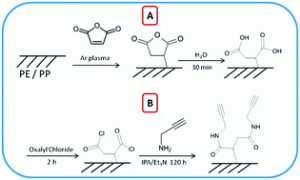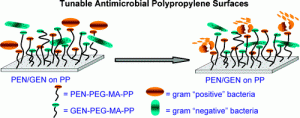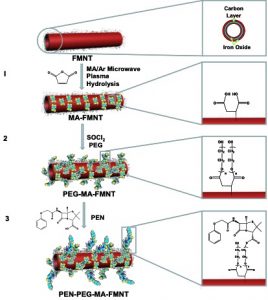H.A. Pearson, M.W. Urban, “Simple click reactions on polymer surfaces leading to antimicrobial behavior” J. Mater. Chem. B, 2014, 2, 2084-2087.
ABSTRACT
Surface reactions were performed on polypropylene (PP) surfaces to retard the simultaneous growth of Staphylococcus aureus (S. aureus) and Pseudomonas putida (P. putida) bacteria. Microwave plasma reactions in the presence of maleic anhydride (MA) resulted in the formation of acid groups on the surface of PP. Such surfaces were further modified by conducting two parallel reactions: (1) poly(ethylene glycol) (PEG) was attached to COOH groups of the PP surface, followed by penicillin V (PEN) reactions to target S. aureus destruction and (2) diglycidyl PEG was attached, followed by gentamicin (GEN) reactions, to create antimicrobial surfaces targeted at P. putida. Simultaneous gram “+” and gram “-” resistance was obtained by varying the PEN/GEN ratios on such modified PP surfaces, thus providing the controllable degree of gram “+” and gram “-” antimicrobial strength. While spectroscopic analyses revealed chemical attachments of PEN and GEN, the effectiveness against proliferation of S. aureus (Gram +) and P. putida (Gram -) bacteria was determined using liquid culture tests. These studies show for the first time the formation of tunable antimicrobial polypropylene surfaces with controllable strength.
N. Aumsuwan, H.A. Pearson, M.W. Urban, “Micro-patterning of streptavidin-biotin-ampicillin/heparin on poly(tetrafluoroethylene) (PTFE) surfaces: simultaneous antimicrobial and anticoagulant activity” Biomater. Sci., 2013, 1, 711-718.
ABSTRACT
Formation of heterogeneous and controllable surface patterns on polymeric materials containing antimicrobial and anticoagulant components represent an attractive way of maintaining synthetic materials “clean” from adverse bio-activities. The primary surface “contaminants” are microbial films as well as blood coagulation, both affecting not only performance of internal or external devices, but often exhibiting detrimental effects on patients. In an effort to simultaneously inhibit formation of microbial films and surface blood coagulation multifunctional assemblies containing streptavidin (STR)-biotinbioconjugates were developed on poly(tetrafluoroethylene) (PTFE) surfaces. Using STR conjugated to a biotin-functionalized PTFE surface, spatially controlled micro-patterning was produced by grafting biotinylated polyethylene glycol (B-PEG) to COOH modified PTFE (MA-PTFE), followed by inkjet micro-printing of biotinylated ampicillin (B-AM) and biotinylated heparin (B-HP) molecules. These surfaces exhibit simultaneous antimicrobial and anticoagulant attributes manifested by “zone of inhibition” and anticoagulant measurements. Quantitative spectroscopic analysis revealed that the required surface density of COOH groups on PTFE is 2.94 × 10−7 g/cm2, and B-PEG and STR densities of 9.2 × 10−8 g/cm2 and 3.5 × 10−8 g/cm2, respectively, are sufficient to achieve simultaneous antimicrobial and anticoagulant responses. These studies also showed that the force required to remove STR-biotin conjugates attached to PTFE surfaces measured by atomic force microscopy is approximately 1090 pN, thus providing desirable surface mechanical stability.
H.A. Pearson, J.M. Andrie, M.W. Urban, “Covalent attachment of multilayers (CAM): a platform for pH switchable antimicrobial and anticoagulant polymeric surfaces” Biomater. Sci., 2014, 2, 512-521.
ABSTRACT
These studies show covalent attachment of multilayers (CAM) to chemically alter surfaces to achieve pH switchable antimicrobial and anticoagulant properties. Polyethylene (PE), poly(tetrafluoroethylene) (PTFE), and silicon (Si) surfaces were functionalized by tethering pH-responsive “switching” polyelectrolytes consisting of poly(2-vinyl pyridine) (P2VP) and poly(acrylic acid) (PAA) terminated with NH2 and COOH groups, respectively. At pH < 2.3, the P2VP segments are protonated and expended, but at pH > 5.5, they collapse while the PAA segments are expanded. The presence of terminal NH2 or COOH moieties on P2VP and PAA, respectively, facilitated the opportunity for covalently bonding ampicillin (AMP) and heparin (HEP) to both polyelectrolyte chains. Such surfaces, when exposed to S. aureus, inhibit the growth of microbial films (AMP) as well as anticoagulant properties (HEP). Comparison of “dynamic” pH dependent surfaces developed in these studies with “static” surfaces terminated with (AMP) entities shows significant enhancement in the longevity of surface activity against microbial film formation.
H.A. Pearson, G.S. Sahukhal, M.O. Elasri, M.W. Urban, “Phage-Bacterium War on Polymeric Surfaces: Can Surface-Anchored Bacteriophages Eliminate Microbial Infections?” Biomacromolecules, 2013, 14(5), 1257-1261.
ABSTRACT
These studies illustrate synthetic paths to covalently attach T1 and Φ11 bacteriophages (phages) to inert polymeric surfaces while maintaining the bacteriophage’s biological activities capable of killing deadly human pathogens. The first step involved the formation of acid (COOH) groups on polyethylene (PE) and polytetrafluoroethylene (PTFE) surfaces using microwave plasma reactions in the presence of maleic anhydride, followed by covalent attachment of T1 and Φ11 species via primary amine groups. The phages effectively retain their biological activity manifested by a rapid infection with their own DNA and effective destruction of Escherichia coli and Staphylococcus aureus human pathogens. These studies show that simultaneous covalent attachment of two biologically active phages effectively destroy both bacterial colonies and eliminate biofilm formation, thus offering an opportunity for an effective combat against multibacterial colonies as well as surface detections of other pathogens.
N. Aumuswan, Sang-Ho Ye, W.R. Wagner, M.W. Urban, “Covalent Attachment of Multilayers on Poly(tetrafluoroethylene) Surfaces,” Langmuir, 2011, 27 (17), 11106-11110.
ABSTRACT
These studies demonstrate a new approach of producing multifunctionalized coatings on poly(tetrafluoroethylene) (PTFE) surfaces by covalent attachments of multilayers (CAM) of heparin (HP) and poly(ethylene glycol) (PEG). This process can be universally applied to other covalently bonded species and was facilitated by microwave plasma reactions in the presence of maleic anhydride which, upon ring-opening and hydrolysis, provided covalent attachment of COOH groups to PTFE. These studies showed that alternating layers of PEG and HP can be covalently attached to COOH-PTFE surfaces, and the volume concentration and surface density of PEG and HP on the PTFE surface achieved by the CAM were 7.02-6.04 × 10-3 g/cm3 (2.1-1.8 × 10-7g/cm2) and 9.3-8.7 × 10-3 g/cm3 (2.8-2.6 × 10-7 g/cm2), respectively. The CAM process may serve numerous applications when the covalent modification of inert polymeric substrates is required and particularly where the presence of bioactive species for biocompatibility enhancement is desirable.
N. Aumsuwan, M.S. McConnell, M.W. Urban, “Tunable Antimicrobial Polypropylene Surfaces: Simultaneous Attachment of Penicillin (Gram +) and Gentamicin (Gram -)” Biomacromolecules, 2009, 10(3), 623-629.
ABSTRACT
These studies demonstrate a new approach of producing multifunctionalized coatings on poly(tetrafluoroethylene) (PTFE) surfaces by covalent attachments of multilayers (CAM) of heparin (HP) and poly(ethylene glycol) (PEG). This process can be universally applied to other covalently bonded species and was facilitated by microwave plasma reactions in the presence of maleic anhydride which, upon ring-opening and hydrolysis, provided covalent attachment of COOH groups to PTFE. These studies showed that alternating layers of PEG and HP can be covalently attached to COOH-PTFE surfaces, and the volume concentration and surface density of PEG and HP on the PTFE surface achieved by the CAM were 7.02-6.04 × 10-3 g/cm3 (2.1-1.8 × 10-7g/cm2) and 9.3-8.7 × 10-3 g/cm3 (2.8-2.6 × 10-7 g/cm2), respectively. The CAM process may serve numerous applications when the covalent modification of inert polymeric substrates is required and particularly where the presence of bioactive species for biocompatibility enhancement is desirable.
M. Yu, M.W. Urban, “Polymeric Surfaces with Anticoagulant, Antifouling, and Antimicrobial Attributes” Macromolecular Symposia, 2009, 283-284(1), 311-318.
ABSTRACT
Recent advances in developments of anticoagulant, antifouling, and antimicrobial polymeric surfaces with the focus on surface modifications of polymeric materials as well as the influence of nanosize materials on interactions with biological systems are discussed. Controllable surface modifications using microwave plasma reactions in the presence of maleic anhydride provides a platform for attaching acid groups to inert polymeric surfaces which serves as a reactive anchor for further reactions. To effectively attach bioactive species inhibiting interactions with biological systems it is often necessary to attach a molecular spacer that facilitates mobility to terminal bioactive species.







